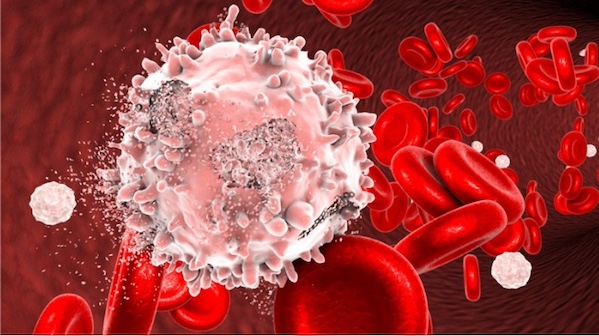Darzalex Faspro in Multiple Myeloma, Imbruvica-Venclexta in Mantle Cell Lymphoma
November 25, 2023
Source: drugdu
 457
457
By Tristan Manalac

Ahead of the 65th Annual Meeting and Exposition of the American Society of Hematology, taking place Dec. 9 to 12, event organizers on Tuesday released late-breaking abstracts providing an early view of some of the most high-impact studies in blood disorders to be presented at the conference.
Focus on two of those studies below.
J&J, Genmab’s Darzalex Faspro
Early data from the Phase III PERSEUS study showed that J&J and Genmab’s subcutaneous anti-CD38 antibody Darzalex Faspro (daratumumab and hyaluronidase-fihj) significantly prolonged progression-free survival (PFS) in patients with newly diagnosed multiple myeloma (NDMM).
PERSEUS enrolled 709 patients in total, of whom 355 were randomly assigned to receive Darzalex Faspro combined with bortezomib, lenalidomide and dexamethasone (VRd). At a median follow-up of 47.5 months, patients treated with the Darzalex Faspro regimen saw a significantly better PFS versus comparators who received VRd alone. The effect had a hazard ratio of 0.42 and a p-value less than 0.0001.
At the time of the analysis, neither study arm had reached median PFS but the estimated 48-week PFS was 84.3% in the Darzalex Faspro arm, compared to 67.7% in the VRd group. The combination regimen was also superior to VRd alone across different prespecified subgroups, including in patients with stage III NDMM and those with high cytogenetic risk.
Overall survival data was immature at the time of the analysis, though J&J and Genmab detected a slightly lower rate of deaths in the Darzalex Faspro arm.
In terms of safety, PERSEUS found a higher rate of serious treatment-emergent adverse events in the Darzalex Faspro arm. However, toxicities leading to discontinuation were more common in patients who received standard of care.
First approved in May 2020 for multiple myeloma (MM), Darzalex Faspro is the subcutaneous formulation of Darzalex, which uses a targeted monoclonal antibody that binds to CD38, which is highly expressed on the surface of MM cells. This mechanism of action allows Darzalex to facilitate the destruction of these cancerous cells while also enhancing the immune system’s activity against them.
J&J, AbbVie, Genentech’s Imbruvica-Venclexta
Also being highlighted at the American Society of Hematology meeting is the Phase III SYMPATICO study, which combined J&J and AbbVie’s Imbruvica (ibrutinib) with AbbVie and Genentech’s Venclexta (venetoclax) for the treatment of patients with relapsed or refractory mantle cell lymphoma (MCL) who had undergone at least one prior line of therapy.
At the time of the analysis, patients treated with both Imbruvica and Venclexta had a median PFS of 31.9 months, compared to only 22.1 months in those who were given Imbruvica alone. This effect was statistically significant, with a hazard ratio of 0.65 and a p-value of 0.0052.
As in the case of Darzalex Faspro, the PFS benefits associated with the Imbruvica-Venclexta combo were consistent across different patient subgroups, including those with TP53-mutant MCL and those with the blastoid variant of the disease. In addition, Imbruvica plus Venclexta also led to a significantly higher complete response rate.
Overall survival was 44.9 months in the Imbruvica-Venclexta arm versus 38.6 months in controls treated with Imbruvica alone.
In terms of safety, the combination regimen induced adverse events grade 3 or higher in 84% of treated patients compared to 76% in the control arm. The most common toxicities included neutropenia, pneumonia, thrombocytopenia, anemia and diarrhea.
Imbruvica is a BTK inhibitor that works by suppressing the proliferation of malignant B-cells, while Venclexta acts on the BCL-2 protein, which is known to be over-expressed in blood cancers and mediates tumor survival and treatment resistance. The two therapies “have distinct and complementary mode of actions,” according to the abstract to be presented at the American Society of Hematology meeting.
Neither drug is approved for MCL. Imbruvica had previously been authorized for treatment under the FDA’s accelerated pathway, but disappointing data from the Phase III SHINE study forced the companies to voluntarily withdraw the drug in this indication.
Read more on
- CoreMedik Unlocks Dual Certifications for Implantation & Intervention of Artificial Heart December 25, 2025
- First in over 70 years! New drug for schizophrenia approved in China December 25, 2025
- Is the “anti-aging drug” a scientific breakthrough or a capital game? December 25, 2025
- Wegovy oral tablets receive FDA approval, ushering in the “dual-dosage era” for GLP-1 weight-loss drugs December 25, 2025
- The leading medical device company’s new venture is aiming for an IPO! December 25, 2025
your submission has already been received.
OK
Subscribe
Please enter a valid Email address!
Submit
The most relevant industry news & insight will be sent to you every two weeks.



